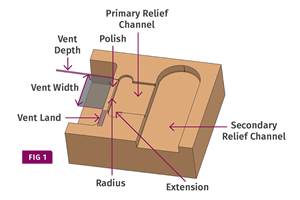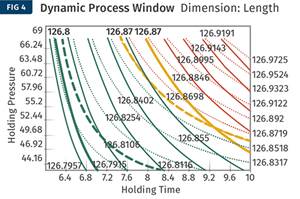Short Shots Redux
Deliberately making a short shot permits you to do a scientific molding viscosity curve. It will also prevent you from damaging the mold by overpacking if you set shot size incorrectly.
In several columns I have addressed why you’d want to make a short shot on purpose. Doing so is an important aspect of practicing “Scientific Molding.” Among many reasons, deliberately making a short shot permits you to do a scientific molding viscosity curve. It will also prevent you from damaging the mold by overpacking if you set shot size incorrectly.
Based on the feedback I have received, it seems I have not communicated the procedure with enough clarity. I have suggested you make a shot size that is 95% to 99.9% of a full part. What exactly does this mean—95% full by weight, volume, size? The answer is volume—the part should be visibly short. You do not want the flow front to hit the end of the cavity. Why not? There are four reasons.
First, most of the time, and especially when you are working the viscosity-curve and mold-flow analysis, we are using the Hagen Poiseuille flow equation. For a round tube, the equation is:
Q = πr4ŌłåP
8μL
Q is the volumetric flow rate.
π is the math constant 3.146.
r is the radius of the tube, gate, runner, or part.
μ is the dynamic viscosity.
L is the length of the tube, gate, runner, or part.
ŌłåP is the pressure loss or drop for the plastic to flow through the flow path.
The key data needed to work the equation is the pressure drop—more specifically, the pressure loss from the beginning of flow (the nozzle) to the end of flow or the last area to fill. Without cavity-pressure sensing at the exact end of flow, which most molders don’t have, the only way we can find the pressure loss from the nozzle to the end of flow is to run a short shot.
With a short shot we know the pressure at the end of flow is zero. No plastic = no pressure. If the flow front hits the parting line, there is some pressure, but no way to tell how much, unless you are fortunate enough to have a cavity-pressure sensor at the short location.
We find the pressure drop for short shots by taking the pressure at transfer, as the machine transfers from first to second stage. This pressure is readily provided by most machines. This is the pressure in the nozzle at the moment the screw reaches the set transfer position. In a hydraulic machine, the hydraulic pressure at transfer must be converted to plastic pressure by multiplying the hydraulic pressure by the machine and barrel intensification ratio.
For example, if the pressure at transfer is 1675 psi hydraulic pressure and the barrel provides a 11.6:1 intensification ratio (it’s rarely 10:1 anymore), the plastic pressure in the nozzle is 19,430 psi. In an electric machine, the pressure at transfer would read 19,430 psi directly. For a short shot, this is the pressure drop or pressure loss to fill the part 98% full by volume. For this mold, we now know that the pressure drop to use in the Hagen Poiseuille equation is 19,430 psi, and this allows us to calculate the plastic’s viscosity. If you are surprised that we lost every single psi of the 19,430 psi injection pressure, it is common to see pressure drops in thin-wall applications over 30,000 psi.
The second reason for short shots is to check the results of a mold-flow analysis. While few molders check flow analyses, those that do should note that the part has to be short to compare what is predicted vs. what actually happens. For filling a mold, the flow analysis is done only to a short shot (then it is followed by packing analysis).
Third, you don’t want to smack the parting line with the plastic flow front during your tests, or in production. This way, we do not have a sudden pressure spike on the parting line that may cause flash and wear the parting line.
Fourth, if you are practicing scientific molding you are processing under velocity control conditions. That is, you have adequate pressure available on first-stage injection to ensure velocity control. If you have this extra pressure available and you begin to pack the mold under first-stage pressure, the machine may overpack a portion of the cavity.
Processing Tip of the Month: This short-shot pressure drop is also of interest in evaluating the difficulty of obtaining high Cpk or consistent parts. The higher this pressure drop, the greater the amplification of all the variables involved in molding. This pressure loss perhaps should be called a “Murphy Multiplier,” referring to “Murphy’s Law,” meaning that anything that can go wrong will go wrong. Anything you can do to minimize the pressure drop will provide for a more robust process. Dissecting how much pressure loss occurs in each of the components of the plastic’s flow path can help troubleshoot problematic molds.
Related Content
Injection Molding: Focus on these Seven Areas to Set a Preventive Maintenance Schedule
Performing fundamental maintenance inspections frequently assures press longevity and process stability. Here’s a checklist to help you stay on top of seven key systems.
Read MoreBack to Basics on Mold Venting (Part 2: Shape, Dimensions, Details)
Here’s how to get the most out of your stationary mold vents.
Read MoreOptimizing Pack & Hold Times for Hot-Runner & Valve-Gated Molds
Using scientific procedures will help you put an end to all that time-consuming trial and error. Part 1 of 2.
Read MoreThree Key Decisions for an Optimal Ejection System
When determining the best ejection option for a tool, molders must consider the ejector’s surface area, location and style.
Read MoreRead Next
People 4.0 – How to Get Buy-In from Your Staff for Industry 4.0 Systems
Implementing a production monitoring system as the foundation of a ‘smart factory’ is about integrating people with new technology as much as it is about integrating machines and computers. Here are tips from a company that has gone through the process.
Read More.jpg;width=70;height=70;mode=crop)








